Australian Terrier
 Australian Terrier
Australian Terrier
The 'Aussie' as he is affectionately known, was originally a vermin killer. When he first came to Australia, he tackled introduced vermin such as rates and mice. Later, he hunted indigenous species, particularly snakes. Today he is one of Australia's most iconic breeds. He loves people and company, adapts well into family life and is easy to train.
Background of the Australian Terrier
The evolution of the Australian Terrier during the 1800's follows the emigration of British people from Scotland and the Border Region to Australia, bringing their Terriers with them. Evidence of this remains in today's Australian Terrier in that:
- His body proportions are those of the old Rough Coated Scotch Terrier which preceded the Scottish and Skye Terriers, and
- His colour, distinctive topknot and the leather up his nose comes from the Dandie Dinmont Terrier.
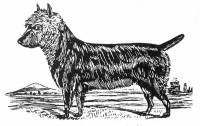 Rough Coated Terrier c 1897
Rough Coated Terrier c 1897
In the catalogue of the first all-breed Dog Show held in Melbourne in 1864, 25 Rough coated Terriers (15 dogs and 10 bitches) over 7 lbs were listed as well as another 7 under 7 lbs[6]. In 1887 the first pedigree of an 'Australian Rough Coated Terrier' was recorded. By 1889, there was an Australian Terrier Club and Breed Standard. In 1890 they held a Show at the Fitzroy Town Hall[3].
Australia's 'Colonial Stigma'
 Aussie Champion "Spratty" 1931
Aussie Champion "Spratty" 1931
But it was reported in the 'Australasian' newspaper that 64 "little mongrels" were shown to judge T H Young[1]. Scathing criticism then broke out in both Melbourne Newspapers 'the Australian' and 'the Leader' about the use of the name 'Australian'. So much so, that the Victorian Poultry and Dog Society emphatically refused to accept the name.
 Australian Terrier Vic 1907
Australian Terrier Vic 1907
Because Australia was first founded by the British as a penal colony, it is inconceivable that this 'colonial stigma' should last for over 100 years! There could be no other logical reason why the name 'Australian' should be denied to a breed that was to become our iconic National Terrier. But so bad was the attitude that in 1888, a person hidden under the non-de-plume of 'Scotch Terrier' wrote:
".. the rough (coated) terrier is an unmitigated mongrel and only fit to use where snakes were too numerous to risk a dog of any value.... we must be thankful that the Victorian Poultry and Dog Society (VP&DS) has not allowed the name Australian to be prostituted to such vile uses and hung around the neck of a wretched mongrel" [2].
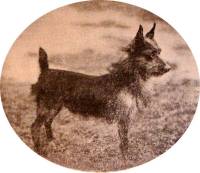 Australian Terrier Vic c 1909
Australian Terrier Vic c 1909
In 1895, the Victorian Poultry and Dog Society became the Victorian Poultry and Kennel Club. By 1896, the Australian Rough Coated Terrier had a breed Standard. On April 17 1909, the 'Weekly Times' newspaper reported that it had received confirmation from the Victorian Poultry and Kennel Club that the name 'Australian Terrier' would finally be permitted[1].
In Victoria, an early exhibitor of our 'Australian Rough Coated Terrier' was Colonel Apps who also ran some dog shows. During the 1890's, he dedicated himself to the development of the Aussie and exported several overseas[4].
The Australian Terrier becomes a Pure Breed in UK
In 1896 and 1898 Australian Terriers were exhibited by Mr Hew Milburn in UK. In 1905 Lady Hutton left Sydney for UK accompanied by a 'good specimen', with a 'brace of bitches' to follow. Some were shown at the Kennel Club Show in UK in 1906.When a Mrs Wood exhibited them at the Ladies' Kennel Association Show in 1907, it caused great excitement, both in England and in Australia.
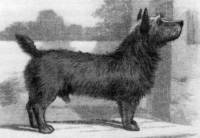 Australian Terrier NSW 1905
Australian Terrier NSW 1905
Meanwhile, back in Australia Lord Hopetoun who was Governor of Victoria from 1889-1895 became the first Australian Governor General after Federation in 1901. Federation meant that each Australian State and Territory was independently governed. Consequently, each Australian State managed its own pure breed dog affairs. Lord Hopetoun also owned Australian Terriers and took them back to England when his term was completed[4].
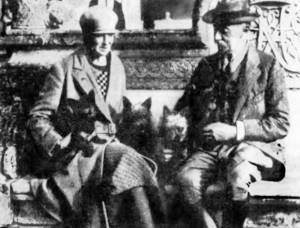 Earl and Countess of Stradbroke
Earl and Countess of Stradbroke
When the Earl was Governor of Victoria from 1921 - 1926, he and the Countess of Stradbroke of Henham Hall, Suffolk who fell in love with these rough coated terriers. They took several back to England with them. Then the Duke of Gloucester also became enchanted by our Aussie. These aristocrats formed and Australian Terrier Club of which the Right Hon.Earl of Stradbroke was President, the Right Hon.Countess of Stradbroke was the Chairman and Mrs Herbert Bassett was the Vice-Chairman. They and their Committee worked hard to convince the Kennel Club (UK) that these dogs were show specimens. Finally, in 1933 the Kennel Club (UK) recognised our Australian Terrier as a pure breed.
Our Aussies continued to be exhibited in UK with Jenny Rodocanachi's "Sam of Toorak' winning he first CC on offer for the breed in UK and by 1934 becoming the first English Champion with his litter sister, 'Sally of Toorak' becoming the first bitch Champion[5].
Recognition of the Australian Terrier in Australia
 Australian Postage Stamp 1980
Australian Postage Stamp 1980
Because Australia did not have a Stud Book, each State had its own registration system. Consequently, when the Kennel Club (UK) accepted the Australian Terrier as a pure breed, the various Australian States and Territories were obliged to follow. Although Australia's only system, the ANKC was finally formed in 1956, we had to wait until 1976 to have Australia's first Stud Book! This was when technology enabled Australia to have co-ordination in the form of a digital data base.
 Australian Terrier 1972 Swap Card
Australian Terrier 1972 Swap Card
During the 1970's the Australian Terrier was so well accepted that they often won high awards against other breeds. The Victorian dog, Ch Tinee Town Tailwagger featured on the swap card pictured, was one of many who paved the way for this iconic Australian breed.
The Australian Terrier Today
 Australian Terrier
Australian Terrier
The Australian Terrier is a sturdy low-set dog, rather long in proportion to height compared to his height at shoulder. He should have a hard-bitten rugged appearance with an untrimmed coat. He should stand around 25 cms (approx 10 ins) high and weigh around approx. 6.5 kg (approx 14 pounds) bitches slightly less.
Head
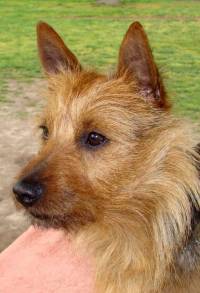 Australian Terrier head
Australian Terrier head
The head should be long with a strong muzzle. The stop should be equidistant between the nose and the occiput. The ears should be sufficiently small to balance the head, set on moderately wide and be free from long hair. The muzzle must be strong and house a normal scissors bite.
The head has two unique features, derived from his Dandie Dinmont ancestry:
- The skull should be covered with a topknot of soft hair,
- The nose leather extends beyond the junction of the nose and the muzzle to the bridge of the nose itself. On young dogs the leather may not be so obvious. But on mature dogs, the leather may extend up the bridge of the nose halfway to the dog's stop.
Body
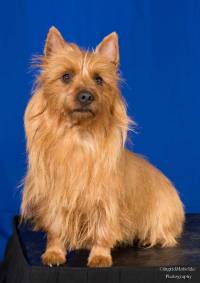 Australian Terrier (Sandy)
Australian Terrier (Sandy)
The neck should be of good length and has a definite ruff of hair which frames the head. It then extends down to the breastbone. The purpose of the ruff was to protect the dog from snake bites.
Because his main work was above ground, although he should be built on top of his straight legs, he still had to enter tunnels to kill a variety of vermin. So his legs must work free from the obstruction of a chest extending below the elbows.
 Australian Terrier (SA)
Australian Terrier (SA)
The body is sturdy, rather long in proportion to height with a level topline, strong loins and a high-set tail. The hindquarters are powerful, so he moves with springy and forceful gait.
Coat
 Australian Terrier (Blue & Tan)
Australian Terrier (Blue & Tan)
His untrimmed double coat comes in two colours, either blue and tan, or sandy or red but never an admixture of the two. In other words if the dog is blue and tan, the tan should never run up the shoulders nor should red hairs run through the blue body coat[3]. In both cases, the topknot should be of a similar colour or lighter.
To maintain a healthy coat, every six months or so, the dead hair needs to be stripped out. But the feet, ears and tail also need to be regularly trimmed.
 Australian Terrier (10 weeks)
Australian Terrier (10 weeks)
Pictured is a puppy around 10 weeks old. When the pup grows up, his ears should become erect and the black should clear off his face.
References and Further Reading
BREAKING NEWS.
We have now published a unique Terrier book 'Terriers Unveiled' Available at our sister site: https://rangeairevision.com/terriers-unveiled/
[1] 'Tyzack's Annual' Compiled by T. W.Tyzack and C.S.Turner. Published 1912 by the Victorian Poultry and Kennel Club Bellamine Bros. Printers, 66-70 Flinders Lane Melbourne Pages 49 - 53 (Blue and Tan) and Pages 53-54 (Sandy)
[2] W. Beilby 'The Dog in Australasia' published George Robertson & Company in 1897 Chapter on Rough or Broken Coated Terriers Page 398
[3] W.A (Fred) Wheatland 'The Australian Kennel Review' 1961
[4] Pamela McDougall Douglass 'The Australian Terrier' History and Origins' Published by K A & P D McDougall Pty Ltd NSW, Chapter 2 Earliest Breeders Page 23
[5] Brenda Brown 'Ralindi' (Scotland) 'The Australian Terrier "Our Dogs" Supplement, the A to Z of Breeds', February 5th, 2021, Page 17
[6] Catalogue of the First Exhibition of Sporting & Other Dogs, Thursday & Friday April 7 & 8, 1864 promoted by the Council of the Acclimatisation Society, printed in Melbourne by Mason & Firth, Printers, Flinders Lane West Page 10.
Also published as 2021 - Jane Harvey - "Mixing in the 'Right' Circles" Published in Dog News Australia (Top Dog Media Pty Ltd Austral NSW) Issue 3 March 2021 Page 8
Our DVD 'Terriers Then & Now' contains more about the Australian Terrier